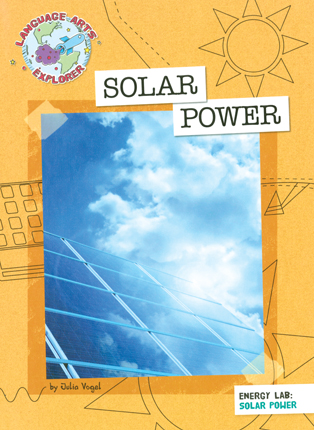| Solar power (Language arts explorer. Energy lab) Author: Vogel, Julia | ||
| Price: $24.46 | ||
Summary:
An introduction to solar power, the history, how solar power is used as an energy source today, and the exciting future of solar energy.
| Accelerated Reader Information: Interest Level: MG Reading Level: 5.50 Points: 1.0 Quiz: 158129 |
Common Core Standards
Grade 4 → Reading → RI Informational Text → 4.RI Key Ideas & Details
Grade 4 → Reading → RI Informational Text → 4.RI Craft & Structure
Grade 4 → Reading → RI Informational Text → 4.RI Integration of Knowledge & Ideas
Grade 4 → Reading → RI Informational Text → 4.RI Range of Reading & Level of Text Complexity
Grade 4 → Reading → RI Informational Text → Texts Illustrating the Complexity, Quality, & Rang
Grade 4 → Reading → CCR College & Career Readiness Anchor Standards fo
Grade 5 → Reading → RI Informational Text → 5.RI Key Ideas & Details
Grade 5 → Reading → RI Informational Text → 5.RI Craft & Structure
Grade 5 → Reading → RI Informational Text → 5.RI Integration of Knowledge & Ideas
Grade 5 → Reading → RI Informational Text → 5.RI Range of Reading & Level of Text Complexity
Grade 5 → Reading → RI Informational Text → Texts Illustrating the Complexity, Quality, & Rang
Grade 5 → Reading → CCR College & Career Readiness Anchor Standards fo
Grade 6 → Reading → RI Informational Text → 6.RI Key Ideas & Details
Grade 6 → Reading → RI Informational Text → 6.RI Craft & Structure
Grade 6 → Reading → RI Informational Text → 6.RI Range of Reading & Level of Text Complexity
Grade 6 → Reading → CCR College & Career Readiness Anchor Standards fo
Grade 7 → Reading → RI Informational Text → 7.RI Craft & Structure
Grade 7 → Reading → RI Informational Text → 7.RI Integration of Knowledge & Ideas
Grade 7 → Reading → CCR College and Career Readiness Anchor Standards for Reading
Reviews:
School Library Journal (04/01/13)
Full Text Reviews:
School Library Journal - 04/01/2013 Gr 4–6—This series offers a timely introduction to energy resources, their advantages, disadvantages, and future outlooks of different options. Opening sections lay out a challenge with two or three general questions. The remaining chapters follow a fictitious researcher through the primary research process. Most missions begin with a science teacher providing fundamental information, then move on to a diverse assortment of scientists, engineers, tour guides, plant managers, etc. Each journal entry concludes with the purpose for the next visit. Text boxes explain related concepts. A quick review and a short list of recall statements and comprehension questions end each challenge. Two routine "Further Missions" extension ideas are included, though they are sometimes unrelated to the content or too difficult. Diagrams are rare; more would help explain confusing topics, such as how a ground source heat pump works. The adequate photos on nearly every other page sometimes don't match their captions. This set is almost identical in treatment and content to the "Examining Energy" series (Oliver Press). - Copyright 2013 Publishers Weekly, Library Journal and/or School Library Journal used with permission.



